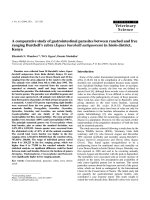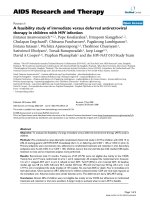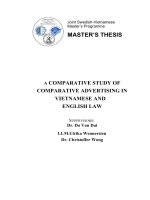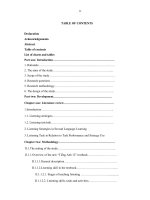A numerical study of h2 o2 detonation waves and their interaction with diverging converging chambers
Bạn đang xem bản rút gọn của tài liệu. Xem và tải ngay bản đầy đủ của tài liệu tại đây (7.37 MB, 240 trang )
A NUMERICAL STUDY OF H
2
/O
2
DETONATION WAVES
AND THEIR INTERACTION WITH
DIVERGING/CONVERGING CHAMBERS
QU QING
NATIONAL UNIVERSITY OF SINGAPORE
2008
A NUMERICAL STUDY OF H
2
/O
2
DETONATION WAVES
AND THEIR INTERACTION WITH
DIVERGING/CONVERGING CHAMBERS
QU QING
(B.ENG., Northwestern Polytechnic University, China)
A THESIS SUBMITTED FOR THE DEGREE OF DOCTOR
OF PHILOSOPHY DEPARTMENT OF MECHANICAL
ENGINEERING NATIONAL UNIVERSITY OF SINGAPORE
2008
1
ACKNOWLEDGEMENTS
I would like to express my deepest gratitude to my supervisors, Prof. Khoo B.C. and
for guiding me into the exciting field of detonation and giving me so many good
suggestions that helped me a lot in my research work. Their enlightenment,
supervision, patience, support, encouragement, as well as criticism, are really
appreciated.
Sincere thanks also go to Dr. Dou H.S. (Temasek Laboratories, Singpapore) for many
helpful and insightful discussions and suggestions. I appreciate his effort in reading
and giving me with valuable suggestions on the earlier version of this thesis.
Moreover, I would like to express my sincere thanks to Prof. Hu X.Y. (Technical
University Munich, Germany) for the original code and considerable assistance, to
Tsai H.M.Dr. and Dr. Liu T.G. (Institute of High Performance Computation, Singapore)
for guidance and helps, I also appreciate the financial support that the National
University of Singapore provides by offering me a research scholarship and an
opportunity to pursue my Ph.D. degree.
My sincere appreciation will go to my dear family. Their love, concern, support and
continuous encouragement help me with tremendous confidence in solving the
problems in my study and life.
Finally, I would like to thank all my friends who have helped me in one way or
another during my entire Ph.D. study. Their friendships are my invaluable asset.
2
TABLE OF CONTENTS
ACKNOWLEDGEMENTS 1
TABLE OF CONTENTS
2
SUMMARY
6
NOMENCLATURE
8
LIST OF FIGURES
13
LIST OF TABLES
19
Chapter 1 Introduction 20
1.1 Background 20
1.1.1 C-J Theory 22
1.1.2 ZND Detonation Wave Structure 27
1.1.3 ZND Detonation Wave Propagation in a Tube 29
1.2 Literature Review 32
1.2.1 Experimental Studies 33
1.2.2 Numerical Studies 39
1.3 Objectives of the Study 47
1.3.1 Motivations 47
1.3.2 Objectives 48
1.4 Organization of the Thesis 49
Chapter 2 Physical and Mathematical Models 55
2.1 Physical Model and Assumptions 55
3
2.2 Governing Equations 55
2.3 Numerical Methods 57
2.3.1 Strang Splitting Scheme 57
2.3.2 Spatial Discretization 58
2.3.3 Temporal Discretization 66
2.3.4 Chemical Kinetics 67
2.3.5 Elementary Chemical Reactions 68
2.3.6 Solving Temperature 70
2.3.7 Normalization 70
2.4 Message Passing Interface (MPI) 71
Chapter 3 Code Verifications 76
3.1 One-dimensional Cases 77
3.2 Two-dimensional Cases 78
3.3 Axisymmetric Cases 80
3.4 Grid Convergence Study 81
Chapter 4 Numerical Results of One-dimensional Detonation Wave 90
4.1 Initialization 90
4.2 Boundary Conditions 90
4.3 Results and Discussions 91
4.3.1 Fundamental Characteristics and Parameters 91
4.3.2 Changes in Concentration of the Species 92
4
4.4 Resolution Study 93
Chapter 5 Numerical Simulation of Two-dimensional Detonation in a
Straight Duct 102
5.1 Initial and Boundary Conditions 102
5.2 Artificial Perturbation 104
5.3 Formation and Evolution of the Cellular Structure 105
5.4 Structure Tracks 107
5.5 Basic Characteristics of Cellular Structure 109
5.6 Details of Cellular Structures 111
5.6.1 Triple-wave Configuration 111
5.6.2 Chemical Reactions in a Cellular Structure 112
5.7 Variation of Detonation parameters in a Cellular Structure 116
5.7.1 Detonation Velocity 116
5.7.2 Pressure 118
5.7.3 Triple-wave Configuration 119
5.8 Resolution Study 120
5.9 Experiment of Artificial Perturbations 122
Chapter 6 Two-dimensional Detonation Wave in a Converging/Diverging
Chamber 150
6.1 Computational Setup 150
6.2 Initial and Boundary Conditions 150
5
6.3 Results and Discussions 152
6.3.1 Diverging Chamber 152
6.3.2 Converging Chamber 156
Chapter 7 Detonation Wave in an Axisymmetric Converging/Diverging
Chamber 183
7.1 Computational Setup 183
7.2 Initial and Boundary Conditions 184
7.3 Results and Discussions 185
7.3.1 Diverging Chamber 185
7.3.2 Converging Chamber 192
7.4 Concluding Summary for Chapter 7 197
Chapter 8 Conclusions and Recommendations 219
8.1 Concluding Summary 219
8.1.1 One- dimensional Detonation Wave 220
8.1.2 Two-dimensional Detonation in a Straight Duct 221
8.1.3 Two-dimensional Detonation in a Diverging /Converging
Chamber 224
8.1.4 Detonation Wave in an Axisymmetric Diverging /Converging
Chamber 225
8.2 Recommendations for Future Work 226
Bibliography 229
6
SUMMARY
Due to its potential application to some high-thrust propulsion systems, the subject on
detonation has been increasingly studied by many researchers from various quarters.
The objective of this thesis is to study the cellular structure of H
2
/O
2
detonation waves,
which entails the formation, evolution and the dynamic characteristics of the cellular
structure, as well as the influences of diverging/converging chambers on the
detonation structure.
In this work, a detailed elementary chemical reaction model with 9 species and 19
elementary reactions is used for a stoichiometric H
2
/O
2
mixture diluted with argon.
The 3
rd
TVD Runge-Kutta method and the weighted essentially non-oscillatory
(WENO) numerical scheme with high resolution grids are employed to discretize the
temporal and convection terms in the governing equations, respectively, while the
source terms are solved by the numerical package of CHEMEQ.
First, the one-dimensional Chapman-Jouguet (C-J) detonation wave was simulated.
The one-dimensional results were then mapped to two-dimensional grids as the initial
condition of the two-dimensional numerical computation in a straight tube. By
introducing some artificial perturbation, the cellular structure of the two-dimensional
detonation wave was successfully simulated. Furthermore, the obtained
two-dimensional detonation wave was placed at the entrance of a two-dimensional
varying cross-sectional chamber. By allowing the detonation wave to propagate
7
through the diverging/converging walls, we investigated the influence of the
diverging/converging walls on the detonation wave and its cellular structure. For
further understanding of these influences, axisymmetric diverging/converging
chambers were introduced. A comparison on the simulation results between the
axisymmetric chambers and the two-dimensional chambers was presented, followed
by a detailed analysis.
8
NOMENCLATURE
a Disturbance coefficient
*
a
∞
Initial sonic speed ahead of the leading shock wave
cj
C
Sonic speed at the C-J plane
i
Cp Specific heat of the ith species
xi
C Mole concentration of the ith species
cj
D
Detonation velocity at the C-J plane
r
d Optimal weight coefficients
e Static energy per unit volume
E
Total energy per unit volume
f
A random number distributed in [-1.0, 1.0]
1/2,ij
F
+
Numerical flux at the x direction
()FU
U
∂
∂
Jacobi Matrix of
()FU
,1/2ij
G
+
Numerical flux at the y direction
()GU
U
∂
∂
Jacobi Matrix of()GU
h Enthalpy per unit mass
i
h Enthalpy per unit mass of the ith species
I
N-1 by N-1 identity matrix
,
f
k
K
Forward reaction rate constants in reaction k
,bk
K
Backward reaction rate constants in reaction k
*
l
Theoretic length of the reaction zone of 1-D
gaseous detonation,
9
const
L Length of the uniform region
ind
l Calculated induction zone length
rxn
l Calculated reaction zone length
p
L
uur
Left eigenvectors of the Jacobi Matrices
D
M
Mach number of detonation wave
M
∞
Mach number of the free stream
N Number of species being considered
p
Pressure
0
p
Initial pressure
1111 1
,,,,
p
TucM Pressure, Temperature, velocity, sound speed and
Mach number of the unburnt gas
2222 2
,,,,
p
TucM Pressure, Temperature, velocity, sound speed and
Mach number of the burnt gas
3333
,,,
p
Tuc Pressure, Temperature, Velocity and sound speed
in the uniform region
atm
p
Atmospheric pressure
cj
p
Pressure at the C-J plane
ign
p
Pressure in the ignition area
max
p
Maximum pressure at a certain location for some
time period
peak
p
Peak pressure at the detonation front
q Heat release per unit mass of reactants
10
r
Relaxation coefficient
R
Specific gas constant
i
R
Specific gas constant for the ith species
u
R
Universal gas constant
p
R
uur
Right eigenvectors of the Jacobi Matrices
0
i
S
Standard state entropy
T
Temperature
char
t Characteristic time of cellular structures
*
T
∞
Initial temperature ahead of the leading shock wave
u Velocity at the x direction
cj
u
Flow velocity at the C-J plane
D
u Detonation wave velocity
v Velocity at the y direction
'
ik
v
Forward chemical stoichiometric coefficients for
the
ith species in reaction k
''
ik
v
Backward chemical stoichiometric coefficients for
the
ith species in reaction k
max
v
Absolute value of the maximum flow velocity at a
certain location for some time period
W Mean molecular weight of the mixture
i
W Molecular weight of the ith species
i
X
Mole fraction of the ith species
i
Y Mass fraction of the ith species
11
t∆ Time step
,
x
y∆∆ Mesh size
Greek Symbols
α
Monotone flux
17ii
α
α
Thermal parameters
ik
α
Third body coefficients
β
Entrance angle of the detonation cellular structure
r
β
Smoothness measurement of the flux function
γ
Specific heat ratio
δ
The acute angle between the incident wave and the
triple-point trajectory line
ε
A positive real small number
θ
Sloping angle of Diverging or converging channels
i
λ
Eigenvalues of the Jacobian matrix of ()FU
j
λ
Eigenvalues of the Jacobian matrix of
()GU
ρ
Density
*
ρ
∞
Initial density ahead of the leading shock wave
ϕ
Exit angle of the detonation cellular structure
φ
The acute angle between the Mach stem and the
triple-point trajectory line
χ
Triple-point trajectory angle
ψ
The acute angle between the transverse wave and
12
the incident wave
ω
Transverse track angle
i
ω
&
Mass production rate of the ith species
,,,
rrrr
ω
ωαα
+−+−
Numerical weight coefficients
∆ The acute angle between the incident wave and the
Mach stem
13
LIST OF FIGURES
Figure Page
Fig. 1.1 Schematic of Rayleigh lines and Hugoniot curve in
22
1/p
ρ
plane 52
Fig. 1.2 Variation of physical properties through a ZND detonation wave 52
Fig. 1.3 Schematic of ZND detonation structure in
22
1/p
ρ
plane 53
Fig. 1.4 Smoked-foil record of a detonation 53
Fig. 1.5 ZND detonation propagation in a tube closed at one end 53
Fig. 1.6 Space-time wave diagram for a ZND detonation wave propagation in a tube 54
Fig. 1.7 Schematic of pressure profile for a ZND detonation propagation in a tube
closed at one end 54
Fig. 2.1 Block Partition with overlap and communication pattern 75
Fig. 3.1 Comparison of the computed solution with the analytic solution for
Sod shock problem 83
Fig. 3.2 Comparison of the computed solution with the analytic solution for
Lax-Harten shock tube problem 84
Fig. 3.3 Computed density contours in the flow field for stationary shock
reflection problem 85
Fig. 3.4 Computed pressure contours in the flow field for supersonic flow
past a 20º wedge 86
Fig. 3.5 Mach reflection in the axisymmetric converging chamber 87
Fig. 3.6 Computed pressure contours for supersonic flow past an
axisymmetric 20º wedge 88
14
Fig. 3.7 Grid convergence study 89
Fig. 4.1 Profile of pressure at time = 320
s
µ
96
Fig. 4.2 Profile of flow velocity at time = 320
s
µ
96
Fig. 4.3 Profile of temperature at time = 320
s
µ
97
Fig. 4.4 Profile of density at time = 320
s
µ
97
Fig. 4.5 Comparison of the computed solution with other works 98
Fig. 4.6 Molecular concentration of H
2
, O
2
and H
2
O at time = 320 s
µ
99
Fig. 4.7 Molecular concentration of O, H and OH at time = 320
s
µ
100
Fig. 4.8 Molecular concentration of HO
2
and H
2
O
2
at time = 320 s
µ
100
Fig. 4.9 Peak pressure and reaction zone width vs mesh size 101
Fig. 5.1 The computational domain and initial shock wave for the 2-D
detonation computation 124
Fig. 5.2 Initial pressure contour with artificial perturbations 124
Fig. 5.3 Formation and evolution of the triple-wave configuration 125
Fig. 5.4 The regular triple-wave configuration at time = 871µs 126
Fig. 5.5 Periodical evolution of triple-wave configuration 127
Fig. 5.6 Numerical cellular structures obtained in the 2-D detonation simulation 128
Fig. 5.7 Numerical detonation cell and its geometry parameters 128
Fig. 5.8 Evolution of the cellular structures with time
(I: 200-250µs, II: 500-550µs, III: 1000-1050µs) 129
Fig. 5.9 Pressure contours at time = 871µs 130
Fig. 5.10 Density contours at time = 871µs 130
15
Fig. 5.11 Temperature contours at time = 871µs 131
Fig. 5.12 Pressure contours at 6 consecutive moments 132
Fig. 5.13 Close-up view of the pressure contours at 4 consecutive moments 133
Fig. 5.14 Pressure contours as the blaster-like wave is formed 134
Fig. 5.15 Concentration contour of H2O with the reaction fronts at time = 871µs 135
Fig. 5.16 Close-up view of the reaction front behind the incident wave at time = 871µs 136
Fig. 5.17 Five regions of a cellular structure 136
Fig. 5.18 H2O concentration at 6 consecutive moments 137
Fig. 5.19 Concentration contours of H
2
and O
2
at time = 875µs 138
Fig. 5.20 Concentration Contours of O, H, OH, HO2, H2O2 and Ar at time = 875µs 139
Fig. 5.21 Location of the detonation front vs time 140
Fig. 5.22 Instantaneous detonation speed vs time 140
Fig. 5.23 Distribution of the instantaneous detonation speed on a cellular structure 141
Fig. 5.24 Pressure distribution on the central line of a cellular structure 141
Fig. 5.25 Geometric relationship of a numerical triple-wave configuration 142
Fig. 5.26 Comparison of the Pressure contours with different mesh size
at time = 871µs 143
Fig. 5.27 Structure with one transverse wave with the mesh size of 0.1mm 144
Fig. 5.28 Structure with one transverse wave with the mesh size of 0.2mm 145
Fig. 5.29 Structure with one transverse wave with the mesh size of 0.05mm 146
Fig. 5.30 Structures with One Transverse Wave with the mesh size of 0.025mm 147
Fig. 5.31 Formation of Triple-wave Configuration with the disturbance
16
coefficient
α
=0.35 148
Fig. 5.32 Formation of Triple-wave Configuration with the disturbance
coefficient
α
=1.0 149
Fig. 6.1 Computational Domains (not to scale) 165
Fig. 6.2 Initial Pressure Distributions 166
Fig. 6.3 Detonation cells pattern at various diverging angles 167
Fig. 6.4 Transition length versus the diverging angle 168
Fig. 6.5 Pressure contours around the turning point P1 for configuration
of diverging angle 30° 169
Fig. 6.6 Pressure contour around the turning point P2 for configuration
of diverging angle 30° 170
Fig. 6.7 Temperature contour around the turning point P2 for configuration
of diverging angle 30° 171
Fig. 6.8 Collision of R and S for configuration of diverging angle 30° 172
Fig. 6.9 Detonation cells pattern at various converging angles 173
Fig. 6.10 Transition length versus the converging angle 174
Fig. 6.11 Pressure contours around the turning point P1 for configuration
of converging angle 25° 175
Fig. 6.12 Detonation cells at various converging angles 176
Fig. 6.13 Pressure contours around the turning point P2 for configuration
of converging angle 25° 177
Fig. 6.14 Detonation cells pattern in the converging chamber around the two
17
corners with different resolutions 178
Fig. 6.15 Pressure contours around the turning point P1 with mesh size
178
Fig. 6.16 Pressure contours around the turning point P2 with 0.05mm grid 180
Fig. 6.17 Structure near the sloping wall with 0.1mm mesh size at t=10.0us 181
Fig. 6.18 Structure near the sloping wall with 0.05mm mesh size at t=10.0us 182
Fig. 7.1 Computational Domains for the axisymmetric chambers (not to scale) 200
Fig. 7.2 Initial Pressure Distributions for the Axisymmetric Cases 201
Fig. 7.3 Evolution of the detonation cellular structures in the converging
chamber of different sloping angles 202
Fig. 7.4 Transition length versus the converging angle 203
Fig. 7.5 Detonation cells and the trajectory angles at various converging angles 204
Fig. 7.6 Trajectory angle versus the converging angle 205
Fig. 7.7 The process of a Mach reflection around the wedge apex 206
Fig. 7.8 Pressure contours around the turning point P1 for configuration
of converging angle 25° 207
Fig. 7.9 Pressure contours around the turning point P2 for configuration
of converging angle 25° 208
Fig. 7.10 Evolution of the detonation cellular structures in the diverging
chamber of different sloping angles 209
Fig. 7.11 Pressure contours in the diverging section for the diverging
configuration of 30° 210
18
Fig. 7.12 Pressure contours in the diverging section for the diverging
configuration of 25° 211
Fig. 7.13 Pressure contours in the diverging section for the diverging
configuration of 25° 212
Fig. 7.14 Pressure contours in the diverging section for the diverging
configuration of 45° 213
Fig. 7.15 Location of the leading front on the central line versus time
in the diverging chamber of 14° 214
Fig. 7.16 Instantaneous speed of the leading front versus time in the diverging
configuration of 14° 215
Fig. 7.17 Instantaneous speed of the leading front versus time in the diverging
chamber of 25° 216
Fig. 7.18 Instantaneous speed of the leading front versus time in the diverging
chamber of 30° 217
Fig. 7.19 Instantaneous speed of the leading front versus time in the diverging
chamber of 45° 218
19
LIST OF TABLES
Table Page
Tab. 2.1 Molecular Weight of Each Species (g) 73
Tab. 2.2 Thermal Parameters (K) (Stull 1971) 73
Tab. 2.3 Reaction Mechanism and the Related Parameters (cm3-mole-sec-cal) 74
Tab. 4.1 Detonation Parameters vs Mesh size 95
Tab. 5.1 Comparison of cell geometries between the current simulation
and experiments 123
Tab. 5.2 Properties of the structures in a straight duct at different resolutions 123
Tab. 6.1 Transition region and ultimate cell size at various diverging angles 164
Tab. 6.2 Transition region and ultimate cell size at various converging angles 164
Tab. 6.3 Details of the triple-point trajectory 164
Tab. 7.1 Transition region and ultimate cell size in the axisymmetric
converging chamber vs in the 2-D converging chamber 199
Tab. 7.2 Details of the triple-point trajectory in the axisymmetric
converging chamber vs in the 2-D converging chamber 199
Chapter 1 Introduction
20
Chapter 1 Introduction
1.1 Background
Combustion process is a vital mechanism in most propulsion systems. The
combustion process can be characterized as either a deflagration or a detonation. The
deflagration is mainly governed by mass and thermal diffusion and has a flame speed
of several meters per second. Usually, a deflagration process produces a slight
decrease in pressure and can be designed as a constant-pressure combustion process.
Engines based on the deflagration process can be constructed to operate at steady state
and are easily optimised with modular analyses of each subsystem. Most conventional
engines, such as turbofans, turbojets, ramjets, and rocket engines, utilize a steady
deflagration process.
In contrast to deflagration, the detonation process takes place much more rapidly and
produces a supersonic combustion wave, or a detonation wave, which propagates at
around two thousand meters per second toward the unburnt reactants. The detonation
wave can be described as a strong shock wave coupled to a reaction zone. The leading
part of a detonation front is a strong shock wave propagating into the unburnt fuel.
The shock heats up the material by compressing it, thus triggering chemical reaction,
and a balance is attained such that the chemical reaction supports the shock. In this
process, material is consumed at O(100) times faster than a flame, making detonation
easily distinguishable from other combustion processes. For example, a good solid
explosive converts energy at a rate of 10
10
watts per square centimeter of its
Chapter 1 Introduction
21
detonation front, which can be compared with the solar energy intercepted by the
earth. A 400m
2
detonation wave operates at a power level roughly equals to all the
power the earth receives from the sun (about 4
×10
16
watts). These virtues of
detonation wave become the primary reason that has been driving people’s interests in
developing engines that employ detonation processes. Examples of these engine
concepts include those employing standing detonation waves, such as the detonation
thrusters, the detonation ramjet, and the oblique detonation wave engine (ODWE), or
those employing intermittent traveling detonation waves, such as the pulse detonation
engine (PDE).
The earlier studies on detonation have gone through various stages. First, the
detonation phenomenon was independently discovered by Berthelot and Vielle (1882),
Mallard and le Chatellier (1881). About 20 years later, the Chapman-Jouguet theory
was used to evaluate some detonation parameters successfully. The simplest theory
was proposed by Chapman (1899) and Jouguet (1905), usually referred to as the C-J
theory. It treats the detonation wave as a discontinuity in one dimension. This theory
can be used to predict the detonation wave velocity without the need to know the
details of the chemical reaction and the detonation wave structure. A significant
advancement in the understanding of the detonation wave structure was made
independently by Zeldovich (1940) in Russia, von Neumann (1942) in the United
States, and Döring (1943) in Germany. They considered the detonation wave as a
leading planar shock wave with a chemical reaction zone behind the shock. Their
treatment has come to be called the ZND model of detonation, and the corresponding
Chapter 1 Introduction
22
detonation wave structure is called the ZND detonation wave structure. Although all
the experimentally observed detonation waves have much more complex cellular
three-dimensional structures resulting from the strong nonlinear coupling between
gas-dynamics and chemical kinetics (Glassman, 1996), the C-J theory and the ZND
model, which assume a planar one-dimensional detonation wave, are still very useful.
An overview of these theories is hence given in the following section to provide some
basic knowledge on detonation physics. More detailed and extended discussions about
detonation physics and phenomena can be found from several textbooks, such as
Fickett and David (1979), Kuo (1986) and Glassman (1996).
1.1.1 C-J Theory
For a steady, planar, one-dimensional detonation wave, with both the reactants and
products modeled as the same perfect gas and the detonation wave modeled as a
discontinuity at which heat addition occurs, the conservations of mass, momentum,
and energy in a coordinate system fixed at the wave front result in,
12 2
22
11 2 2 2
() (1.1)
() (1.2)
DD
DD
uuu
pup uu
ρ
ρ
ρρ
γ
γ
= −
+ = + −
22
12
2
12
11
() (1.3)
12 12
DD
pp
uq uu
γ
ργρ
+ + = + −
−−
where
D
u is the detonation wave velocity, q the heat release per unit mass of
reactants due to chemical reaction, and
γ
ratio of the specific heat of the gas.
1
ρ
,
1
p
,
and
1
u represent the density, pressure, and velocity of the unburnt gas, and
2
ρ
,
2
p
,
and
2
u represent the density, pressure, and velocity of the burnt gas. Since there are
only three equations, an additional equation is needed to solve for the four unknowns
Chapter 1 Introduction
23
2
p
,
2
ρ
,
2
u and
D
u . This additional equation will be obtained through the following
analysis. Combining the mass and momentum conservation equations leads to the
Rayleigh relation,
22
21 1
21
11
()/( )
D
pp u
ρ
ρρ
− − = − .
(1.4)
Manipulating Eqs. (1.1) − (1.3) results in the following Hugoniot relation,
21
21
21 21
111
()()().
12
pp
pp q
γ
γρρ ρρ
− − − + = (1.5)
−
Figure 1.1 shows the schematic of the Hugoniot curve and the Rayleigh line in the
22
1/p
ρ
plane. In this figure, the point corresponding to the unburnt gaseous state is
denoted by A. Apparently, all the Rayleigh lines pass through this point A. The
possible final states are defined by the points of intersection of the Rayleigh line and
the Hugoniot curve. Among all the straight lines passing through point A, there are
two lines which are tangential to the Hugoniot curve. The corresponding tangent
points are defined as the C-J (Chapman-Jouguet) points, denoted in the figure by point
U for the upper C-J point and L for the lower C-J point. The horizontal and vertical
lines passing through point A correspond to a constant pressure and a
constant-volume process, respectively. The Hugoniot curve is divided into five
regions, namely regions I~V, by the two tangent lines and the horizontal and vertical
lines. Region V is unphysical since the Rayleigh lines defined by Eq. (1.4) cannot
have positive slope. Regions I and II are called detonation branch, within which the
velocity of the wave front is supersonic; regions III and IV are called deflagration
branch, within which the velocity of the wave front is subsonic. The upper C-J point









